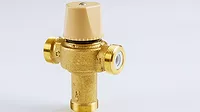Disappearing Btus
John Siegenthaler, PE

Too bad Btus are so dumb. Instead of complying with our simple concept of following the arrows, they have this “thing” about temperature - always wanting to move from warmer to cooler. They don't care about what we want them to do. They don't care about the arrows on the schematic. They don't even care if the building is properly heated as they move about.
Just like electrical energy can flow into and out of a battery, Btus can move into and out of any thermal mass in a hydronic system. Temperature difference determines the direction and speed of their movement. So, until someone figures out how to make Btus smarter, we must ensure they always go in the right direction.
Bidirectional
Many modern hydronic systems combine an indirect water heater with high-mass radiant panels for space heating. An example of such a system is shown in Figure 1.
Systems piped like this allow the domestic hot water (DHW) load to be controlled in either priority or nonpriority modes.
Priority control is pretty simple: Whenever the DHW load is calling for heat, all other loads in the system are prevented from receiving heat. In most cases, a “priority override” control scheme is used to limit the time that the DHW load can operate before allowing other loads to go back online. This guards against freeze-up in situations where the DHW load cannot be satisfied due to a variety of abnormal conditions (such as a malfunctioning tank thermostat).
In nonpriority mode, the DHW load is treated just like any other load. It can operate by itself (if it's the only load calling for heat at the time), or it can operate simultaneously with any of the other loads.
Over the years, I've listened to and participated in several discussions on the merit of prioritized versus nonprioritized DHW heating in hydronic systems. Both approaches have strengths and weaknesses. This month, I want to exam a weakness of nonprioritized DHW control that may not be obvious until an irate customer calls you on the carpet after it occurs.

I often refer to a cold concrete slab as a “black hole for Btus.” Any Btu that gets close to cold concrete gets “sucked in,” just like anything that gets close to a cosmic black hole. The combination of high thermal mass and low temperature allows a cold slab to pull Btus from the warm embedded tubing three to four times faster than under design load conditions. This can lead to a very undesirable situation in which a rapid cooling of the DHW tank takes place if it happens to be calling for heat at the same time a cool slab comes online.
To see why this happens, just remember that all hydronic systems seek thermal equilibrium. They want to operate where the rate of heat release equals the rate of heat input. When a cool slab comes online, after a significant setback period, it can often soak up heat while supplied with water temperature that's significantly cooler than the potable water in the DHW tank. If the DHW circuit is operating when the cool slab comes online, water leaving the DHW tank heat exchanger will likely pass through portions of the system that are significantly cooler than the potable water stored in the tank.
Given this possibility, and the fact that heat only knows to move from warm to cool, you can probably see what's going to happen. As the Btus are rapidly stripped out of the DHW tank, its delivery temperature plummets. Someone standing in the shower eagerly anticipating a “tropical downpour” will soon undergo the “man overboard” arctic survival experience.
A couple of other “black hole loads” to be watchful of are snowmelting and pool heating. A cold driveway may be the ultimate heat sink to absorb heat from the indirect DHW tank if the two loads operate simultaneously. A swimming pool, even a warm one, isn't far behind in this respect.
Preserving DHW
So, how do you prevent this? Well, the easiest way is to make DHW a priority load. The need for such priority is especially important when a condensing boiler is used. Such systems typically do not have the minimum boiler inlet temperature protection provided by intelligent mixing devices used in combination with conventional boilers. Instead, the system stabilizes at a relatively low equilibrium supply temperature, where the heat output of the boiler matches the heat absorption rate of the load. Although such low-temperature operation boosts boiler efficiency, it also provides a ready heat sink should the DHW circuit be operating at the same time.
Fortunately, the controls on most currently available condensing boilers treat domestic water heating as a priority load and thus prevent this possibility.
Some multiload systems using modern condensing boilers also “trick” the boiler into high-temperature operation to supply other higher temperature loads, such as baseboard and fan-coils. This is usually done by creating a phantom call for domestic water heating (e.g., a dry contact closure to the DHW terminal on the boiler control board), and then redirecting the hot water flow from the boiler to the alternate high-temperature load.
If you plan to do this, be sure you provide external relay logic to interrupt the other high-temperature load upon a call for domestic water heating. An example of such logic is shown in Figure 2.
The potential to inadvertently drain Btus from an indirect DHW tank is a salient argument in favor of prioritized DHW control. If you choose otherwise, be sure the system can't extract heat already added to the potable water. Remember, heat exchangers work both ways; it's just a matter of temperature difference.
Links
Looking for a reprint of this article?
From high-res PDFs to custom plaques, order your copy today!






